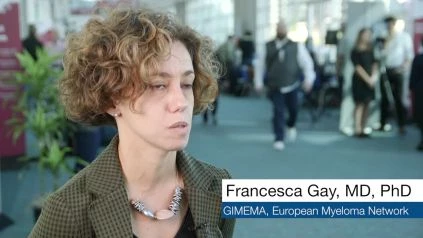Francesca Gay, MD, PhD of the GIMEMA, European Myeloma Network discusses Duration of Maintenance and the Advantage to High Risk Patients of the TOURMALINE-MM3 phase 3 study.
Key findings, which will be presented by Dr. Meletios Dimopoulos, include:
The trial achieved its primary endpoint with NINLARO resulting in a statistically significant improvement in PFS versus placebo in adult patients diagnosed with multiple myeloma who responded to HDT and ASCT as assessed by an Independent Review Committee (IRC) (HR 0.72; 95% CI: 0.582, 0.890; p-value=0.002). This corresponds to a 28 percent reduction in risk of progression or death and a 39 percent improvement in PFS with NINLARO.
Per IRC assessment, median PFS for patients in the NINLARO arm was 26.5 months compared to 21.3 months in the placebo arm.
Conversion from documented minimal residual disease (MRD) positivity at study entry to MRD negativity occurred at a higher rate among patients treated with NINLARO compared with placebo (12 percent versus 7 percent, respectively).
NINLARO maintenance led to higher rates of deepened response compared with placebo (relative risk 1.41; 95 percent CI: 1.10, 1.80; p=0.0042).
PFS benefit was seen broadly across subgroups, including ISS III (HR 0.661), PI-exposed (HR 0.750), PI-naïve (HR 0.497), and patients with high-risk cytogenetics (HR 0.625).
Secondary endpoints including median PFS2 and OS have not yet been reached in either arm. Median follow-up was 31 months.
Global Quality of Life scores (EORTC QLQ-C30) for patients on NINLARO were similar to those on placebo.
The safety profile of NINLARO in the maintenance setting is consistent with previously reported results of single-agent NINLARO use.
Discontinuation of treatment due to adverse events (AE) was low, at 7 percent in the NINLARO arm compared to 5 percent in the placebo arm.
Grade ?3 AEs were experienced by 42 percent of patients receiving NINLARO versus 26 percent receiving placebo.
Patients in the NINLARO arm experienced serious AEs at a rate of 27 percent versus 20 percent in the placebo arm.
Common grade ?3 AEs in both the NINLARO and placebo arms included infections (15 and 8 percent, respectively) including pneumonia (6 and 4 percent, respectively), gastrointestinal disorders (6 and 1 percent, respectively), neutropenia (5 and 3 percent, respectively) and thrombocytopenia (5 and <1 percent, respectively).
On the NINLARO arm, peripheral neuropathy events were observed in 19 percent of patients versus 15 percent on the placebo arm. In the NINLARO arm, <1 percent of peripheral neuropathy events were Grade 3 compared with 0 in the placebo arm.
The rate of second primary malignancies was 3 percent in both arms.
One patient in the NINLARO arm died on study while no patients in the placebo arm did. The single study death was considered to be treatment-related and was due to pneumonia.
About the TOURMALINE-MM3 Trial
TOURMALINE-MM3 is a randomized, placebo-controlled, double-blind Phase 3 study of 656 patients, designed to determine the effect of NINLARO® (ixazomib) maintenance therapy on progression-free survival (PFS), compared to placebo, in participants with multiple myeloma who have had a response (complete response [CR], very good partial response [VGPR], or partial response [PR]) to induction therapy followed by high-dose therapy (HDT) and autologous stem cell transplant (ASCT). The primary endpoint is progression-free survival (PFS). A key secondary endpoint includes overall survival (OS). For additional information: https://www.clinicaltrials.gov/ct2/show/NCT02181413.

